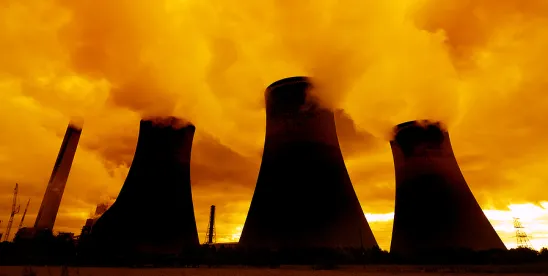On May 23, 2025, President Trump signed four new executive orders (the Orders) to “usher in a nuclear energy renaissance.” In an article, the White House explained that the Orders provide “a path forward for nuclear innovation” as they “allow for reactor design testing at [Department of Energy (DOE)] labs, clear the way for construction on federal lands to protect national and economic security, and remove regulatory barriers by requiring the Nuclear Regulatory Commission [(NRC)] to issue timely licensing decisions.” Characterizing the Orders as “the most significant nuclear regulatory reform actions taken in decades,” the White House declared that it is “restoring a strong American nuclear industrial base, rebuilding a secure and sovereign domestic nuclear fuel supply chain, and leading the world towards a future fueled by American nuclear energy.” Below is a summary of some of the significant aspects of the Orders.
Reforming Nuclear Reactor Testing at the Department of Energy
- Finds that the design, construction, and operation of certain DOE-controlled advanced reactors fall within DOE’s jurisdiction.
- Directs the Secretary of Energy to take actions to reform and streamline National Laboratory processes for reactor testing at DOE, including but not limited to, revising regulations to expedite the approval of reactors under DOE’s jurisdiction to enable test reactors to be safely operational within 2 years following submission of a substantially complete application.
- Directs the Secretary of Energy to create a pilot program for reactor construction and operation outside the National Laboratories, and to approve at least three reactors under this program with the goal of achieving criticality in each of the three reactors by July 4, 2026.
- Directs the Secretary of Energy to eliminate or expedite internal environmental reviews for authorizations, permits, approvals, and other activities related to reactor testing.
Deploying Nuclear Reactors for National Security
- Directs the Secretary of Defense, acting through the Secretary of the Army, to create a program for building and deploying a nuclear reactor at a domestic military installation by September 30, 2028.
- Directs the Secretary of Energy to take actions to deploy a privately funded advanced reactor to power artificial intelligence (AI) infrastructure and meet other national security objectives at a DOE site within 30 months.
- Directs the Secretary of Energy to designate certain AI data centers that are located at or operated in coordination with DOE facilities as critical defense facilities, where appropriate, and the electrical infrastructure that power them as defense critical electric infrastructure.
- Directs the Secretary of Energy to make available at least 20 metric tons of high-assay low-enriched uranium for private sector nuclear projects powering AI infrastructure at DOE sites.
- Directs the Secretaries of Energy and Defense to enable the construction and operation of privately funded nuclear fuel facilities at DOE and/or Department of Defense (DOD) controlled sites for use in national security reactors, commercial power reactors, and non-power research reactors.
- Directs the Secretary of State to take certain actions to promote the U.S. nuclear industry in the development of commercial civil nuclear projects globally.
Ordering the Reform of the Nuclear Regulatory Commission
- Establishes a goal of quadrupling American nuclear energy capacity from 100 gigawatts (GW) to 400 GW by 2050.
- Directs the reorganization of the NRC and a reduction in force in consultation with the Department of Government Efficiency.
- Directs the NRC to undertake a wholesale review and revision of its regulations and guidance within 18 months, including but not limited to, establishing:
- Fixed deadlines to evaluate and approve new reactor license applications within 18 months and applications for the continued operation of existing reactors within one year;
- Science-based radiation limits, instead of relying on the linear no-threshold model for radiation exposure;
- An expedited approval process for reactor designs that have been safely tested by the DOD or DOE; and
- A process for high-volume licensing of microreactors and modular reactors.
Reinvigorating the Nuclear Industrial Base
- Directs the Secretary of Energy to recommend a national policy regarding management of spent nuclear fuel and the development and deployment of advanced fuel cycle capabilities, evaluate policies concerning commercial recycling and reprocessing of nuclear fuels, and make recommendations for the efficient use of nuclear waste materials.
- Directs the Secretary of Energy to develop a plan to expand domestic uranium processing and enrichment capabilities to meet projected civilian and defense reactor needs.
- Halts the surplus plutonium disposition program, with certain exceptions, and directs the Secretary of Energy to process and make surplus plutonium available for advanced reactor fuel fabrication.
- Leverages the authority in the Defense Production Act to seek voluntary agreements with domestic nuclear energy companies for the cooperative procurement of enriched uranium and for consultation regarding the management of spent nuclear fuel.
- Directs DOE to prioritize the facilitation of 5 GW of power uprates to existing reactors and construction of 10 new large reactors by 2030.
- Directs DOE’s Loan Programs Office and U.S. Small Business Administration to prioritize funding to support the nuclear energy industry.
- Seeks to expand the American nuclear workforce by directing the Secretaries of Labor and Education to increase participation in nuclear energy-related training and apprenticeship programs and ordering the Secretary of Energy to increase access to DOE’s National Laboratories for nuclear engineering students.
Overall, the Orders signal a renewed commitment to revitalize the U.S. nuclear energy industry and build upon a well-established bipartisan consensus in favor of nuclear innovation, accelerating nuclear deployment, and strengthening domestic uranium supply chains. Nonetheless, efforts to reduce federal staffing and weaken NRC’s regulatory independence could compromise the viability of the Trump administration’s goal to “unleash nuclear energy in the U.S.,” placing greater importance on sound regulatory execution and legally durable policymaking.



 />i
/>i

